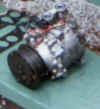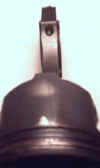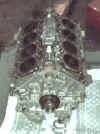 |
A/C
Compressor |
 |
This
is the front of the block after being completely disassembled. The only
thing left in it is the balance shaft. You can tell this block is meant
for racing. It's cast for purpose. It's extremely light weight and very
small. The bolts on the side are for the alternator bracket. It's bolted
to the side of the block. The aluminum is also very soft. It's not very
hard to put a nick or mark into it. |
 |
A
picture of the crank. Each connecting rod has it's own rod journal. They
are on the same throws but they are offset slightly. It's a fairly beefy
unit. The counterweights are huge! The end of the crank has 8 bolts. There
isn't any balance to it like a 5.0 V8. It's all internally balanced with
help from the balance shaft |
 |
Another
clearer picture of the crank. You can see in cross drilling of the crank a
little better in this picture. The mains and the rod journals have been
cross drilled at the factory for better oiling of the mains and the rod
journals. One less machining process I won't have to pay for! |
 |
Here
is a great picture of the block deck and the disked piston. There are no
valve reliefs, only a small dish to reduce compression slightly. They
head's have a 39cc combustion chamber and with a flat top piston the
compression would probably be 10.5 or 11.0:1. You can see all the coolant
holes where the coolant enters from the heads. The 3 large holes you see
along the bottom of the block(right side) are the oil drain holes. The oil
that goes up into the heads are then drained down into the oil pan through
those holes. |
 |
This is the number one main of the block. It's VERY
thick. It's looks like the mains you see on the Ford Racing Performance
Parts R302 race bred block. This would be even stronger as all the mains
are connected together as a main girdle tying them all the mains together.
You can see it contains 4 bolts on the front main bearing journal. All the
journals are like that, as well as having extra bolts along the edge of
the girdle. This effectively makes it a 6 bolt main block.
You can also see the windage tray installed on the
rear part of the motor. I believe this is probably a Duratech V6 part as
it only covers 6 rods and doesn't cover the front part of the block to
cover all 8 rods.
Yes,
this is in my living room! I did this while the wife was away for the
week. She would kill me if I had done it while she was here! |
 |
This is the inside of the oil pan. Nothing special
here. Standard Ford pan, no baffles or anything. When the motor gets put
back together a couple baffles will be welded into the sump around the oil
pump pickup. That way when extreme corning occurs all the oil will not
slosh away from the pick up and allow the pump to start sucking air.
It's
a pretty elaborate piece just for an oil pan. It's not stamped steel or
aluminum. It's cast aluminum. It's a lot heavier than the old 351W oil pan
I used to have in the 81 RSX. |
 |
Here is the crank installed in block. The rods and
pistons have been removed. This shows the rod journals being split as
well.
You can also see all the bolts holding down the mains
as well as the extra bolts along the edge of the girdle bolting it all
together. I don't know if you can or not but looking into the bottom of
the block you cannot see the balance shaft. It's totally enclosed within
the block. The only place you can really see it is through the top of the
block where the oil separator is installed.
If
you look at the bottom of journals 2, 3 and 4 you can see some holes
there. Those are the oil return holes to the oil pan. The oil comes
outside of the heads dropping through them through the block then the main
journal/girdle and finally into the pan. They holes from the block to the
girdle are SEVERELY mismatched. The holes in the girdle are much larger
than what's in the block. I won't be matching these together. This would
take meat away from the journals on the block and probably weaken it. |
 |
Another angle on the inside of the short block.
You
can see some of the cross drilling on the rod journals as well as some oil
drain back holes in the block up inside the block where some of the
counterweights are. Along the side of the outside of the block you can see
some of the webbing. |
 |
Knock Sensors. They won't be used in our application
unless the ignition system I get can take advantage of them but I doubt
it. There are two, one in the front and one in the back of the block.
Some
people on the V8 SHO mailing list that their motors ping on 87 octane
fuel. These might be the problem. If they are not sensitive enough or not
working the computer will not pull timing out and the motor with detonate.
It's my contention with such small combustion chambers, high 10:1
compression and a high revving nature, 93 octane or higher should be used.
With the propane we are using octane won't be a problem. It's rated at
110. |
 |
It's
always hard to describe this thing. This is the bottom of the motor. On
most motors all the main bearing journals that hold the crank in are
separate. On motors like the 5.0 V8 from the Mustang, all the mains are
separated. In the SHO V8 they are all tied together. This strengthens the
bottom end of the motor by tying all the mains together to one main web.
This resists the mains from walking and allowing a spun bearing and all
other kinds of problems. With the kind of power we'll be making, this will
help it all stay together. |
 |
Another
picture of the mains/girdle from the bottom of the motor. This is showing
it from the side. It's pretty thick with a lot of webbing. You could say
the block is two pieces. The main upper and the lower pictured here. |
 |
|
 |
The
oil pickup that sits on the oil pan. |
 |
The
oil pump. This is a gerotor design. It is bolted to the front of the crank
snout and is turned by the crank. It's supposed to be VERY efficient. You
can see how it's indexed to the crank and the pick up is bolted to the
pump. |
 |
The
oil pump from the side. It's very thin to fit between the front main and
front cover. |
| |
This
is the complete oil pump assembly. It will be completely replaced when the
motor goes back together. The motor had an oiling problem to begin with
and replacing the pump and pick up would be cheap insurance. I don't know
how I will be able to prime the motor before I start it up. |
 |
Oil
Separator. This is actually a part of the PCV System. It helps take out
the gases and pressure from in the block and let's it circulate back
through the motor to be burnt and sent out the exhaust. |
 |
Oil
Separator opened up. |
 |
Here is the piston and rod assembly. The piston is a
short skirt design. The compression height is approximately 1.18".
That is pretty small. This means that the pin that holds piston to the rod
is 1.18" from the center of that pin to the top of the piston.
Besides the other Duratech engines(2.5 & 3.0 V6), this is the only
engine I know with a short skirt. Again, comparing it to the 5.0 V8, the
compression height is around 1.7". Alot of stroked motors use these
types of pistons. This causes the piston to rod a little more than the
normal longer skirt pistons. Looking at the picture you can see the smudge
on the piston skirt showing that the skirt has been contacting the
cylinder wall. This is a piston with only 13,000 miles on it.
The rod/ratio of this motor is 1.7" as well.
This is a very favorable rod ratio.
The piston is held on to the connecting rod with
spirolox. The piston is held on with a full floating pin, not a pressed
pin. This is how most race car pistons are assembled to allow quick
changing of the pistons on the rods. I was able to easily remove the pin
and separate the piston from the rod.
This rod is a powered forged connecting rod. They
take the powered and press it together at high pressure to make the rod.
They then break the big end of the rod and bolt it back together. This
supposedly makes the rod stronger. It also makes the rod unusable when
it's been removed from the engine. The bolts are stretch-to-yield bolts
which also makes them "use once" designs. I've seen people reuse
this types of bolts over again though. As long as you don't stretch them
past their stretch point they should be ok. We'll be replacing them
anyways with lightweight aluminum rods.
As
you've seen in a lot of the other photos this motor was put together and
designed like a race engine. Light weight, lots of webbing, short skirt
pistons, full floating pistons. |
 |
The bolts are stretch-to-yield bolts which also makes
them "use once" designs. I've seen people reuse this types of
bolts over again though. As long as you don't stretch them past their
stretch point they should be ok. They will be replaced however with
something stronger.
These
bolts aren't like most rod bolts either. Most rod bolts are pushed in
through the top of the rod and them the cap is put on and a nut is then
used to secure the cap. On these the cap is put onto the rod and the bolt
is screwed in from the cap side and the rod on top is threaded for the
bolt. Again, another race feature of the SHO V8. |
 |
This
is a picture of the short block, in my living room, with the oil pan off.
You can see how it's all crammed in there under the oil pan. The oil pick
up, the windage tray and the pickup for the oil pump which leads to the
front of the block. |
 |
The
complete short block outside on the front porch. I put it there after I
disassembled it down to it's 175 pound weight. You can see how small this
engine really is. The deck is close to the main block. I think this is a
good design for strength. This motor almost seems bomb proof. |
 |
This
is the short block from the back (driver's side) of the motor. You can see
all the webbing on the back and the thick flange of the rear of the crank.
The plug in the center top of the rear of the block is where the rear
bearing of the balance shaft is. The little tunnel on the bottom of the
oil pan is where the drain plug is. |
 |
Again,
the short block. This is from the side. The long bolts on the bottom of
the left hand side of the picture are for the A/C compressor. You can see
the dishes in each of the pistons from the view and lighting. You can see
the oil separator assembled. Removing it shows a small view of the balance
shaft. You can also see the knock sensors installed on either side of the
oil separator. |
 |
Windage tray installed on the short block. This shows
it attached without the oil pump or pick up in the way. Oil falls over the
crank and lands in the tray. It then falls into the pan from the whole on
the left.
The
purpose of the windage tray is to keep oil from wrapping around the crank
and aerating the oil. This allows the crank to spin without the added drag
of the oil wrapping itself around the crank. This adds a few HP. Also this
is something I won't need to get fabricated as I can use the stock one! |
 |
Windage
tray removed. |
 |
Windage
tray removed showing the inside. |
| |
|

